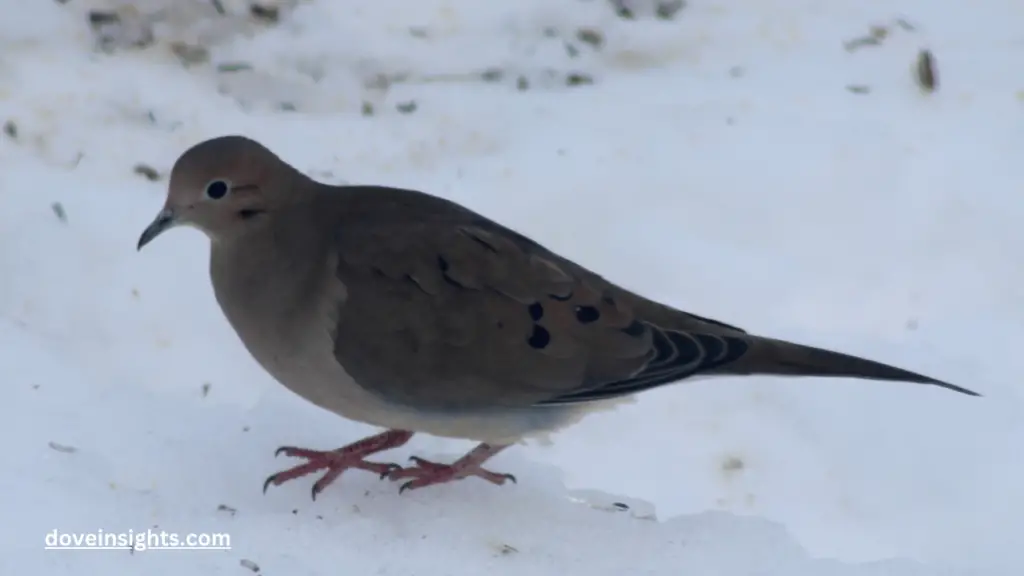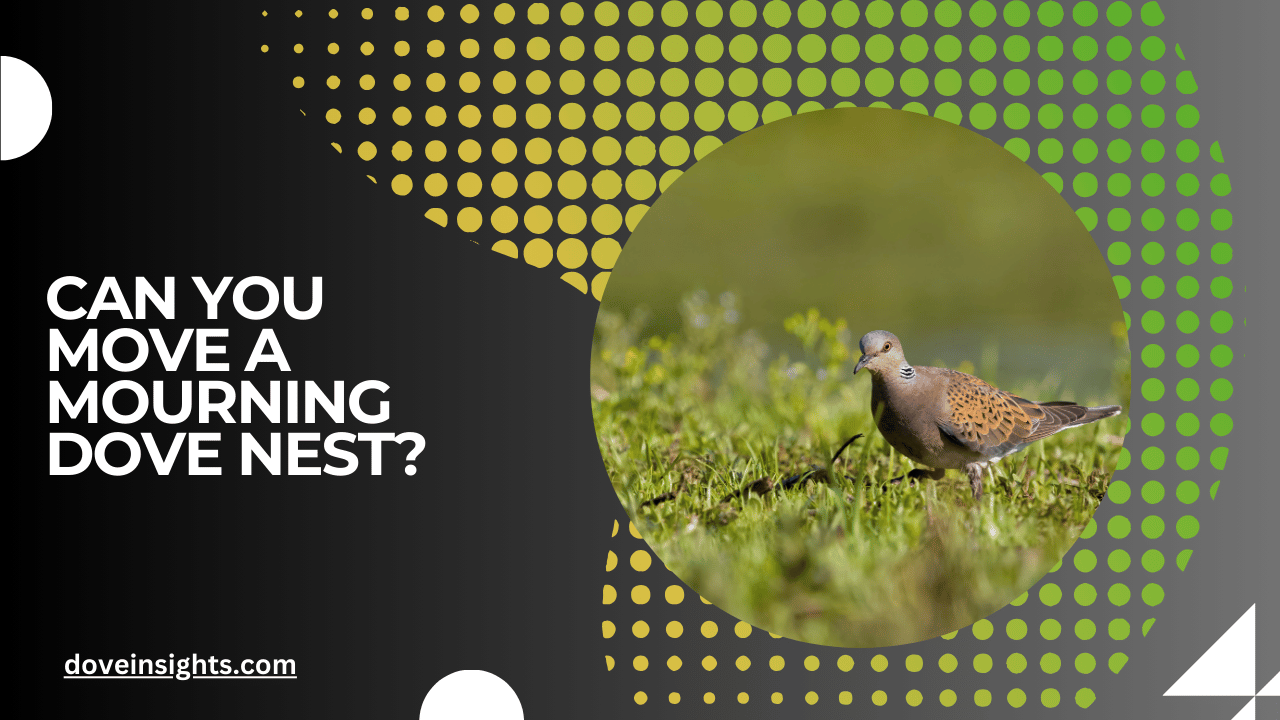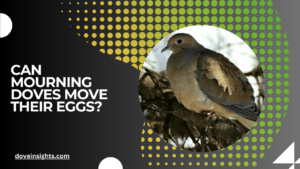Mourning doves are one of the most beloved birds in North America, known for their soothing cooing sounds and graceful, fluttering flight.
They often choose to build their nests in trees, shrubs, or even in less conventional locations, such as rooftops or balconies. These nests, usually simple structures made of twigs, serve as a place for the doves to incubate their eggs and raise their young.
However, a question that frequently arises among birdwatchers and homeowners alike is, “Can you move a mourning dove nest?”
This query can arise in many different contexts, such as when a nest is built in a location that may pose risks to the birds or to humans, or when a property owner wishes to relocate the nest for the safety of the birds.
Moving a mourning dove nest may seem like an easy solution, but it’s a far more complex issue than it appears. Ethical considerations, the well-being of the birds, and legal protections all play a crucial role in this situation.
Whether you’re trying to relocate a nest to keep it safe from predators or you simply want to understand more about these peaceful creatures, knowing the answers to questions about nest relocation is important.
This article will explore the complexities surrounding the relocation of mourning dove nests, the possible risks involved, and what you should know before making any decisions.
By the end of this article, you will have a thorough understanding of whether it is advisable or even legal to move a mourning dove nest, and if so, how to do so in a way that respects the bird’s natural instincts and legal protections.
Contents
- 1 The Nesting Habits of Mourning Doves
- 2 Legal Considerations in Relocating a Mourning Dove Nest
- 3 The Risks of Moving a Mourning Dove Nest
- 4 Alternative Solutions to Moving a Mourning Dove Nest
- 5 What to Do if the Nest Is in Immediate Danger
- 6 Conclusion:
- 7 FAQ’s
- 7.0.1 Is it legal to move a mourning dove nest?
- 7.0.2 What should I do if a mourning dove nest is in a dangerous location?
- 7.0.3 Can the parents still care for their eggs if I move the nest?
- 7.0.4 What are the risks of moving a mourning dove nest?
- 7.0.5 Can I relocate the nest to another tree or location?
- 7.0.6 How can I help protect a mourning dove nest?
The Nesting Habits of Mourning Doves
Before diving into whether a mourning dove nest can be moved, it’s important to understand the nesting behavior of these birds. Mourning doves are relatively low-maintenance when it comes to building their nests.
They don’t construct elaborate, complex nests like some other bird species. Instead, mourning doves typically use twigs, grasses, and leaves to create a simple, shallow bowl-shaped structure.
These nests are often built in trees, shrubs, or high locations such as roof eaves or balconies.
What makes mourning doves unique is that they do not always build nests in highly secluded areas. Their nests can sometimes be in easily accessible locations, which may bring them into closer contact with human activity or potential dangers.
Once the nest is constructed, the female usually lays two eggs, which are incubated by both the male and female for around two weeks.
Mourning doves are protective of their nests and will often stay near them, using distraction tactics if predators approach. However, if they feel the area is too dangerous, they may abandon the nest altogether. Given this sensitivity to disturbances, it’s essential to consider their needs before attempting any kind of nest relocation.
Legal Considerations in Relocating a Mourning Dove Nest
The first and most crucial point to consider when thinking about moving a mourning dove nest is legality.
In the United States, mourning doves are protected under the Migratory Bird Treaty Act (MBTA), which makes it illegal to disturb, relocate, or harm the nest, eggs, or young birds. This law is in place to protect migratory birds, including mourning doves, from human interference during critical stages of their life cycle.
Relocating a mourning dove nest without a proper permit can have legal consequences, so it’s important to understand the laws in your area before taking any action.
If you find that the nest is in a dangerous or inconvenient spot, it’s a good idea to reach out to local wildlife authorities, bird rescue organizations, or animal control for guidance.
These professionals can advise you on how to handle the situation in a way that adheres to legal and ethical standards.
Moreover, even if the nest is not physically moved, disturbing the birds during the incubation or hatching period can cause the parents to abandon the nest, resulting in the death of the eggs or chicks.
Thus, moving a nest is not only illegal but can also be detrimental to the birds’ survival.
The Risks of Moving a Mourning Dove Nest
While it may be tempting to move a mourning dove nest to a safer or more convenient location, doing so can have significant risks for both the birds and their eggs. First and foremost, the physical act of relocating the nest can cause stress to the adult birds, which may result in them abandoning their eggs.
Mourning doves are highly sensitive to disturbances, and any disruption to the nest can cause the parents to leave.
Additionally, there is a high likelihood that the new location will not have the right conditions to successfully support the nest.
For example, if the nest is moved too far or to a location that doesn’t provide sufficient cover, safety, or the correct temperature, the eggs may not hatch. Even if the nest is moved to a more suitable location, the parents may reject the nest if it’s too unfamiliar or if they feel threatened by the move.
There’s also the risk of inadvertently causing damage to the nest itself. Mourning dove nests are often fragile and can be easily broken or disturbed when handled incorrectly.
Since the adult doves rely on their nest for incubation and protection, any damage to the nest could prevent the eggs from hatching or lead to the loss of the entire nesting attempt.
Alternative Solutions to Moving a Mourning Dove Nest
If you find that a mourning dove nest is in an inconvenient or dangerous location, there are several alternative solutions to moving the nest.
Rather than attempting to physically relocate the nest, there are safer and more effective ways to help ensure the safety of the birds and their young.
One option is to protect the nest by creating a barrier around it.
If the nest is in a location where there is a threat from predators or human interference, consider placing a mesh or protective cage around the nest to keep it safe. This will allow the birds to continue nesting without the risk of disturbance.
Another solution is to contact wildlife professionals who can provide guidance. Many wildlife rehabilitation centers, animal control offices, or bird sanctuaries have the expertise to handle situations where a nest is at risk.
They can advise you on what steps to take, such as temporarily relocating the nest (if it is absolutely necessary) or ensuring that the birds are given adequate space and protection.
What to Do if the Nest Is in Immediate Danger

In rare cases, there may be an imminent threat to the mourning dove nest, such as a severe storm, a predator, or construction work that cannot be postponed. If the nest is in immediate danger, it’s best to act quickly but carefully.
Minimize contact with the nest to avoid further disturbing the birds. If possible, try to shield the nest from external threats, such as covering it with a temporary protective cover or relocating it only a small distance to a safer area.
Again, reaching out to wildlife professionals is essential.
They will be able to assess the situation and help you take appropriate action that minimizes the risk of harm to the birds.
Conclusion:
The question of whether you can move a mourning dove nest is not as straightforward as it may seem. While it’s technically possible to relocate a nest, the risks involved—both for the birds and for the integrity of the nest—make it a complicated process.
Ethical and legal considerations must be taken into account, as well as the welfare of the doves. Moving a nest without professional guidance can lead to stress, abandonment, or failure of the nesting attempt.
Instead of moving the nest, the best approach is to minimize disturbances and offer protection if the nest is in a potentially dangerous location.
For those who are unsure of how to proceed, reaching out to wildlife experts is always the safest and most responsible option. By doing so, you can ensure that you are not only following the law but also supporting the long-term survival and well-being of these beautiful birds.
FAQ’s
Is it legal to move a mourning dove nest?
No, mourning doves are protected by the Migratory Bird Treaty Act, and it is illegal to disturb, move, or harm their nests.
What should I do if a mourning dove nest is in a dangerous location?
Rather than moving the nest, consider creating a protective barrier around it or contact local wildlife professionals for guidance.
Can the parents still care for their eggs if I move the nest?
Moving the nest can cause the parents to abandon the eggs due to stress and unfamiliarity with the new location.
What are the risks of moving a mourning dove nest?
Moving a nest can lead to abandonment of the eggs, stress to the parents, and damage to the nest.
Can I relocate the nest to another tree or location?
While it is physically possible, it’s not advisable, as the mourning doves may not accept the new location, and the eggs may not survive.
How can I help protect a mourning dove nest?
You can protect the nest by placing a barrier around it or ensuring the area is safe from predators and disturbances.








